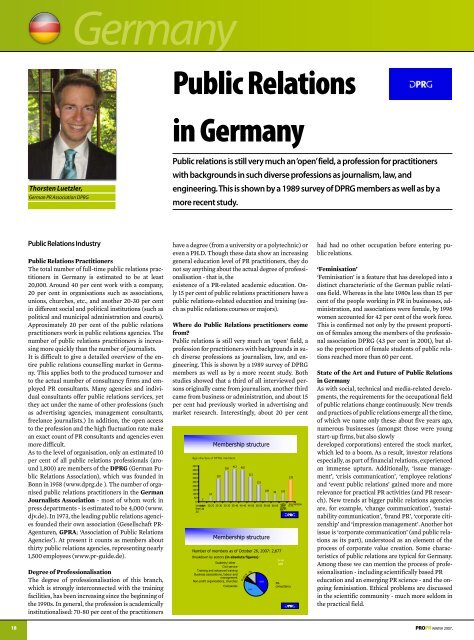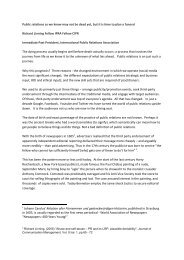CASE STUDY Pfizer's PR campaign „Openly about sex“ - PRO.PR
CASE STUDY Pfizer's PR campaign „Openly about sex“ - PRO.PR
CASE STUDY Pfizer's PR campaign „Openly about sex“ - PRO.PR
You also want an ePaper? Increase the reach of your titles
YUMPU automatically turns print PDFs into web optimized ePapers that Google loves.
.<br />
Thorsten Luetzler,<br />
German <strong>PR</strong> Association D<strong>PR</strong>G<br />
Public Relations Industry<br />
Germany<br />
Public Relations Practitioners<br />
The total number of full-time public relations practitioners<br />
in Germany is estimated to be at least<br />
20,000. Around 40 per cent work with a company,<br />
20 per cent in organisations such as associations,<br />
unions, churches, etc., and another 20-30 per cent<br />
in different social and political institutions (such as<br />
political and municipal administration and courts).<br />
Approximately 20 per cent of the public relations<br />
practitioners work in public relations agencies. The<br />
number of public relations practitioners is increasing<br />
more quickly than the number of journalists.<br />
It is difficult to give a detailed overview of the entire<br />
public relations counselling market in Germany.<br />
This applies both to the produced turnover and<br />
to the actual number of consultancy firms and employed<br />
<strong>PR</strong> consultants. Many agencies and individual<br />
consultants offer public relations services, yet<br />
they act under the name of other professions (such<br />
as advertising agencies, management consultants,<br />
freelance journalists.) In addition, the open access<br />
to the profession and the high fluctuation rate make<br />
an exact count of <strong>PR</strong> consultants and agencies even<br />
more difficult.<br />
As to the level of organisation, only an estimated 10<br />
per cent of all public relations professionals (around<br />
1,800) are members of the D<strong>PR</strong>G (German Public<br />
Relations Association), which was founded in<br />
Bonn in 1958 (www.dprg.de ). The number of organised<br />
public relations practitioners in the German<br />
Journalists Association - most of whom work in<br />
press departments - is estimated to be 4,000 (www.<br />
djv.de). In 1973, the leading public relations agencies<br />
founded their own association (Gesellschaft <strong>PR</strong>-<br />
Agenturen, G<strong>PR</strong>A; ‘Association of Public Relations<br />
Agencies’). At present it counts as members <strong>about</strong><br />
thirty public relations agencies, representing nearly<br />
1,500 employees (www.pr-guide.de).<br />
Degree of Professionalisation<br />
The degree of professionalisation of this branch,<br />
which is strongly interconnected with the training<br />
facilities, has been increasing since the beginning of<br />
the 1990s. In general, the profession is academically<br />
institutionalised: 70-80 per cent of the practitioners<br />
Public Relations<br />
in Germany<br />
Public relations is still very much an ‘open’ field, a profession for practitioners<br />
with backgrounds in such diverse professions as journalism, law, and<br />
engineering. This is shown by a 1989 survey of D<strong>PR</strong>G members as well as by a<br />
more recent study.<br />
have a degree (from a university or a polytechnic) or<br />
even a PH.D. Though these data show an increasing<br />
general education level of <strong>PR</strong> practitioners, they do<br />
not say anything <strong>about</strong> the actual degree of professionalisation<br />
- that is, the<br />
existence of a <strong>PR</strong>-related academic education. Only<br />
15 per cent of public relations practitioners have a<br />
public relations-related education and training (such<br />
as public relations courses or majors).<br />
Where do Public Relations practitioners come<br />
from?<br />
Public relations is still very much an ‘open’ field, a<br />
profession for practitioners with backgrounds in such<br />
diverse professions as journalism, law, and engineering.<br />
This is shown by a 1989 survey of D<strong>PR</strong>G<br />
members as well as by a more recent study. Both<br />
studies showed that a third of all interviewed persons<br />
originally came from journalism, another third<br />
came from business or administration, and <strong>about</strong> 15<br />
per cent had previously worked in advertising and<br />
market research. Interestingly, <strong>about</strong> 20 per cent<br />
Membership structure<br />
Age structure of D<strong>PR</strong>G members<br />
450<br />
400<br />
350<br />
300<br />
250<br />
200<br />
150<br />
100<br />
50<br />
2<br />
0<br />
younger unter<br />
than 20<br />
20<br />
67<br />
292<br />
390<br />
had had no other occupation before entering public<br />
relations.<br />
‘Feminisation’<br />
‘Feminisation’ is a feature that has developed into a<br />
distinct characteristic of the German public relations<br />
field. Whereas in the late 1980s less than 15 per<br />
cent of the people working in <strong>PR</strong> in businesses, administration,<br />
and associations were female, by 1996<br />
women accounted for 42 per cent of the work force.<br />
This is confirmed not only by the present proportion<br />
of females among the members of the professional<br />
association D<strong>PR</strong>G (43 per cent in 2001), but also<br />
the proportion of female students of public relations<br />
reached more than 60 per cent.<br />
State of the Art and Future of Public Relations<br />
in Germany<br />
As with social, technical and media-related developments,<br />
the requirements for the occupational field<br />
of public relations change continuously. New trends<br />
and practices of public relations emerge all the time,<br />
of which we name only these: <strong>about</strong> five years ago,<br />
numerous businesses (amongst those were young<br />
start-up firms, but also slowly<br />
developed corporations) entered the stock market,<br />
which led to a boom. As a result, investor relations<br />
especially, as part of financial relations, experienced<br />
an immense upturn. Additionally, ‘issue management’,<br />
‘crisis communication’, ‘employee relations’<br />
and ‘event public relations’ gained more and more<br />
relevance for practical <strong>PR</strong> activities (and <strong>PR</strong> research).<br />
New trends at bigger public relations agencies<br />
are, for example, ‘change communication’, ‘sustainability<br />
communication’, ‘brand <strong>PR</strong>’, ‘corporate citizenship’<br />
and ‘impression management’. Another hot<br />
issue is ‘corporate communication’ (and public relations<br />
as its part), understood as an element of the<br />
process of corporate value creation. Some characteristics<br />
of public relations are typical for Germany.<br />
Among these we can mention the process of professionalisation<br />
- including scientifically based <strong>PR</strong><br />
education and an emerging <strong>PR</strong> science - and the ongoing<br />
feminisation. Ethical problems are discussed<br />
in the scientific community - much more seldom in<br />
the practical field.<br />
1 <strong>PR</strong>O<strong>PR</strong> winter 2007.<br />
412 402<br />
313<br />
older no mention<br />
20-25 25-30 30-35 35-40 40-45 45-50 50-55 55-60 60-65 älter k. A.<br />
than<br />
als 65<br />
65<br />
215<br />
109<br />
Membership structure<br />
Number of members as of October 26, 2007: 2,677<br />
Breakdown by sectors (in absolute figures):<br />
61<br />
37<br />
34<br />
Students/ other<br />
Civil service<br />
Training and advanced training<br />
350<br />
Business associations, labour and<br />
management<br />
40<br />
Non-profit organisations, churches<br />
Companies<br />
1145<br />
1010<br />
94<br />
103<br />
7**P<br />
R98<br />
278<br />
<strong>PR</strong>consultancy<br />
1<br />
1



